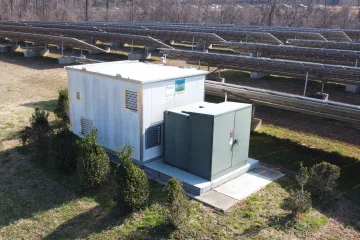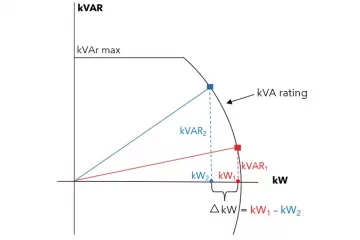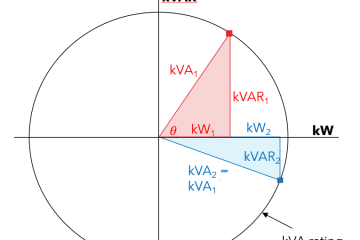This is the second of five articles in the series “Reactive Power in Utility-Scale Solar PV Applications.”
In Part 1 of this series, we looked at the differences and relationship between real, reactive, and apparent power. We also looked at the production and absorption of reactive power by equipment such as transformers, reactors, and capacitors.
Before we get deep into utility-scale solar PV and reactive power, we’ll take a look at reactive power impacts on distribution and transmission operations.
Distribution System
On distribution systems, reactive power flow has three impacts:
- Increases the amount of voltage drop between the substation and customer loads
- Increases real power losses (kWhr) in the conductors
- Reduces the amount of the real power-carrying capacity (kW) of equipment.
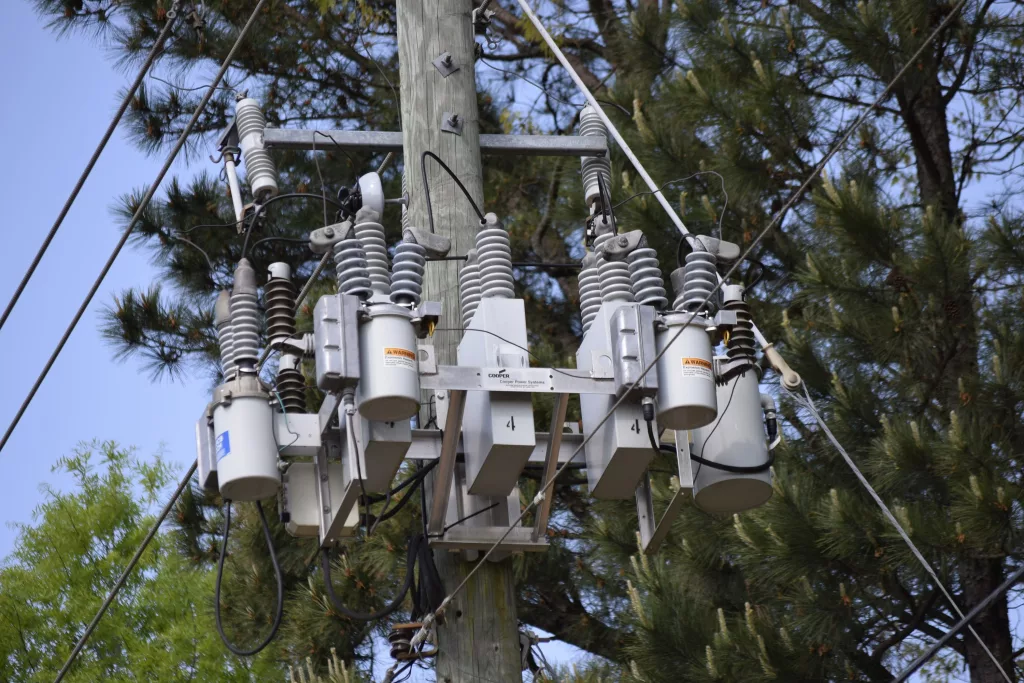
Shunt Capacitor Bank on Distribution Feeder
To reduce the magnitude and transfer distance of reactive power, it is generally preferable to locate reactive power sources, such as shunt capacitor banks, electrically close to the equipment that is consuming reactive power.
Shunt capacitor banks, such as that shown in the photo, have been used for over 100 years for reactive power compensation. Shunt capacitor banks that are located on the feeder some distance from the transmission-distribution substation reduce the above three impacts.
Large shunt capacitor banks are common in substations, but their purpose is usually to provide reactive power compensation and voltage support to the transmission system.
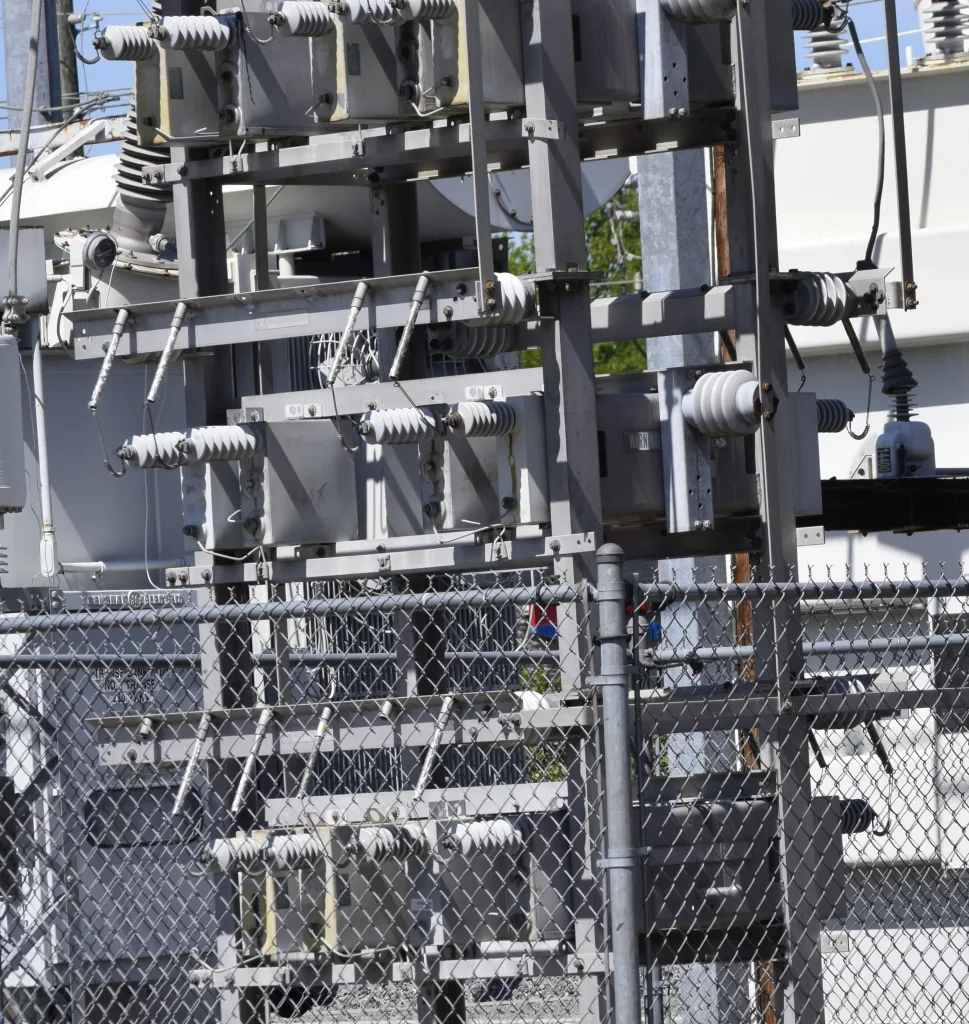
Substation Rack-Mounted Capacitor Bank
DERs (Distributed Energy Resources) impact voltage on feeder, no matter how small they are. For small DER penetration, the voltage impacts are relatively small. For higher penetrations and utility-scale DER, the potential for adverse voltage impacts becomes greater.
In particular, if the real power (kW) being supplied by a DER is greater than the real power load downstream of the DER, a voltage rise in the vicinity of the DER will be created by the real power generation flowing back to the substation through the conductor resistance.
Since inverters can change power and current output (or absorption) almost instantaneously, changes in inverter reactive power can be used to control voltage.
In the US, control of voltage by DER was not permissible by governing standards until the publication of the IEEE 1547-2018 standard, which permits this assuming that states and utilities have adopted the standard. We’ll discuss this more in a later article in this series.
Transmission System
Reactive power control and support on transmission systems is critical to the reliable operation of the transmission system. VAr compensation is done for several different reasons, including real power transfer increase, voltage control and real power loss reduction.
While generators are sources or sinks of reactive power. For rotating synchronous generations, this is performed through control of their field excitation systems for rotating synchronous generators. For IBR (Inverter Based Resources), this is done through inverter controls.
VArs are not transferred readily over the long distances that generating stations are frequently located from the load centers. As a result, it is common for reactive power equipment to be applied in transmission substations.
In the past, synchronous condensers were commonly applied, which are synchronous rotating machines which only produce or consume VArs and not real power. Due to their high operating expenses, they are not applied as frequently today. Power electronic equipment such as STATCOM, described below, can be used instead in some cases.
VAr compensation on EHV stems, 500 kV and 765 kV, is generally shunt reactors applied at either one end or both ends of a line. The shunt reactors are connected line-to-ground, and compensate for the shunt, line-to-ground capacitance of the EHV lines.
Shunt capacitor banks are rarely applied at EHV, but are often applied in HV transmission substations. Large banks can be switched on and off the system to accommodate the changing reactive power needs on the system.
Dynamic Voltage Support
The above means of reactive power support are sometimes referred to as static support. Dynamic reactive power support can also be supplied by equipment that includes power electronics. With dynamic reactive power support, the reactive power response can be ½ cycle or less.
Dynamic voltage support can be designed and implemented to improve voltage stability and improve power quality during certain system events and operating conditions. This is true for both distribution and transmission systems. Sometimes fast support is needed to suppress voltage fluctuations caused by loads such as arc furnaces.
SVCs (Static VAr Compensators), STATCOMs (Static Synchronous Compensators), and even IBR (Inverter-Based Resources) such as solar PV and wind can provide dynamic voltage support by supplying the system with a current to compensate for system conditions.
The figure shows an SVC in which the inductive reactive current is controlled by switching the power electronics (thyristors in this case), and the capacitive current is controlled by mechanical switching of capacitors.
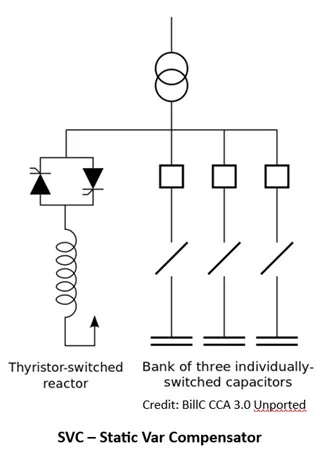
SVCs and STATCOMs can also increase real power transfer capabilities on transmission systems.
For distribution systems, IEEE 1547-2018 lists the requirements, which are not mandatory, by which DERs provide dynamic voltage support. The supplied current may have both real and reactive components, during low-voltage ride-through and high-voltage ride-through operation, when voltage support on the distribution and transmission system is needed. It is only to be used with mutual agreement between the DER owner and the distribution system operator.
In the next article in this series Reactive Power in Utility-Scale Solar PV Applications, we’ll look at “IBRs – Inverter-Based Resources Reactive Power Capabilities.”
Tim Taylor is the founder of Electric Distribution Academy, and all his courses are hosted exclusively on HeatSpring. Tim is the instructor for several courses focused on utility distribution, including “Interconnection of Utility-Scale Solar PV to Distribution” and “Understanding IEEE 1547-2018 – Interconnection Standard for DER on Distribution.
